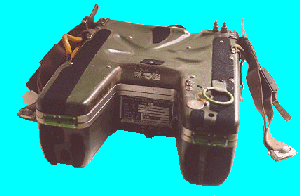
 Aircrew often end up ejecting in areas where their survival is challenged by the elements,
so they are provided with a large supply of varied equipment and food to sustain them.
On their persons they are equipped with gear that includes signaling devices and
floatation devices to help them immediatly after landing. Once they have conquered the
immediate dangers, their long term survival is generally handled by the equipment packed
in the survival kits of the ejection seats. There are three basic types and several
sub-types in use. I define the three major types as soft kits, rigid kits, and rigid kits
with integral oxygen. Among the sub-types is the 'Hit and Run' kit which is a small,
lightweight kit with a handle or straps for use in rapid evasion where the full kit may be
to cumbersome.
Aircrew often end up ejecting in areas where their survival is challenged by the elements,
so they are provided with a large supply of varied equipment and food to sustain them.
On their persons they are equipped with gear that includes signaling devices and
floatation devices to help them immediatly after landing. Once they have conquered the
immediate dangers, their long term survival is generally handled by the equipment packed
in the survival kits of the ejection seats. There are three basic types and several
sub-types in use. I define the three major types as soft kits, rigid kits, and rigid kits
with integral oxygen. Among the sub-types is the 'Hit and Run' kit which is a small,
lightweight kit with a handle or straps for use in rapid evasion where the full kit may be
to cumbersome.
The kit box pictured here is the SKU-2/A which is used in the GRU-7 series of seats. These seats are used in the early F-14 Tomcat (GRU-7A), A-6 Intruder (GRU-7) and the EA-6B Prowler (EAGRU-7). It is a rigid kit with integral oxygen. This type is used in particular when the crew might eject at high altitude, and where early separation from the seat would risk the crewman losing conciousness from lack of oxygen if the oxygen was seat mounted. The kit is made of two pieces of molded fiberglass with aluminum fittings. The kit weighs 22 pounds with only the oxygen bottles. The kit is designed to remain attatched by the lap belts to the crewman's harness after ejection and seat separation. While hanging under the parachute, the crewman has the option (with this kit) of deploying the seat kit. This would separate the two halves of the kit and leave the upper section still attatched to the harness. The lower section, with its contents would drop to the end of a lanyard which is usually about 20ft. Attatched to the lanyard is normally a life raft which is activated by the lanyard pull and should normally inflate before water impact. Over land, the kit would be retained intact, and opened after landing. The kit contents, other than the raft are usually secured in a smaller soft container. The contented, which vary heavily from seat to seat, climate to climate, and even season to season, may include some or all of the following:
This seat kit, like most in use in the USAF, USN and USMC, is equipped with an AN/URT-33 personal survival beacon. This is a small radio which emits a signal on the universal emergency channel (Guard Channel). The beeper has a selector switch accessable through a slot in the right knee of the kit front. The selector allows for automatic actuation of the beeper on seat separation via a lanyard, or manual actuation after the crewman has landed and opened the kit. The manual selection is useful for times where the aircraft may go down in enemy held territory where immediate notification of the enemy of the crews location may not be desirable.
Here are some other photos of this seat kit:
SR-1 Survival Kit used by NASA in the SR-71. Shows the kit plus some of the contents.
OV-1 Mohawk Survival kit box. The Martin-Baker/US Army Mk. J5D seat has the emergency oxygen bottle mounted on the main beam assembly, so the kit does not include oxygen bottles.
